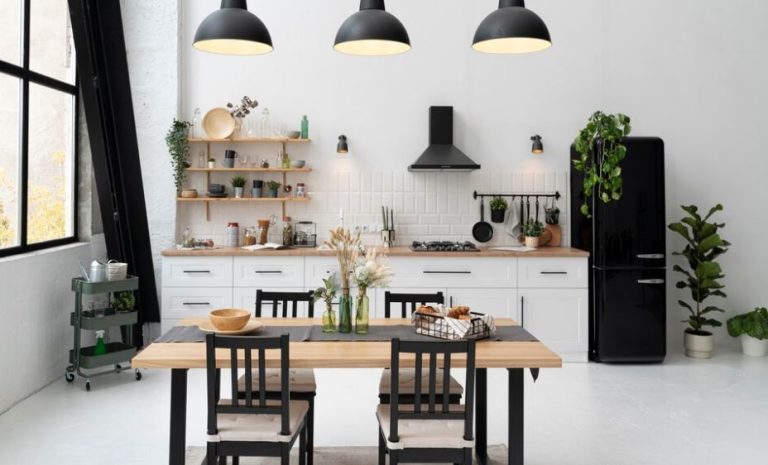The kitchen and dining room table is one of the most emotionally charged pieces in home design. Despite their apparent simplicity, these surfaces are the setting for some of the most treasured moments in life. They see impromptu homework sessions, secrets shared over coffee in the morning, and feasts that last long into the night.
The table has evolved over the last ten years from a passive fixture to a focal point of design. Today’s dining and kitchen tables are designed to reflect the way we connect, cook, and gather, whether they are made of sleek tempered glass or rustic reclaimed wood.
Beyond Furniture: A Mirror of Way of Life
For many people, selecting a dining table is similar to deciding on the pace of their house. Long talks and hearty meals are suggested by a broad oak table. Space-conscious living, espresso-fueled mornings, and intimate dinners are all hinted at by a small, circular marble-top table.
Kitchen and Dining Room Tables Overview
| Feature | Description |
|---|---|
| Common Materials | Solid wood, engineered wood, glass, metal, marble, composite |
| Popular Shapes | Round, rectangular, oval, square, expandable |
| Average Price Range | $150 – $2,500+ (depending on size, brand, material) |
| Sizing Recommendations | 24 inches per person for comfort; 42–48 inches clearance from walls or furniture |
| Notable Brands | IKEA, West Elm, Crate & Barrel, Wayfair, Pottery Barn, Interwood |
| Functional Variants | Drop-leaf, extendable, counter-height, bench-style |
| Best Use Cases | Family meals, formal entertaining, casual dining, multifunctional spaces |
| Sustainable Options | FSC-certified wood, recycled materials, ethically sourced designs |
| Design Trends | Mixed materials, farmhouse-modern hybrids, integrated storage, dual-purpose configurations |
Renowned for her work on small townhomes and urban lofts, interior designer Lauren Gillespie likens the table to a “conductor’s podium”—the platform from which domestic life is directed. “It’s not just about how the table looks,” she says, adding that it’s also about how people feel when they sit at it.
Design That Adjusts to the Situation
The distinction between the kitchen and the dining area has become more hazy in today’s open-plan homes. Before the sun sets, one table could be used as a prep station, breakfast bar, work-from-home desk, and dinner setting. Because of this, the best dining room and kitchen tables are no longer static; instead, they are incredibly functional, adaptable, and carefully sized.
Brands like Interwood and IKEA are satisfying the demands of people who live in small spaces without sacrificing style by incorporating versatile features like drop-leaves or self-storing extensions.
Material Issues: From Sustainability to Style
The choice of material affects longevity, maintenance, and usability in addition to style. For instance, solid wood is incredibly resilient and gains character over time, but glass is lighter and can fit in smaller spaces. Marble is elegant, but it requires maintenance. Notably, eco-conscious consumers looking for beauty with a purpose are increasingly choosing recycled materials.
The market has significantly improved in the last five years in terms of providing sustainable options, ranging from tables made from recycled metals and plastics to hardwood that has earned FSC certification. This is indicative of a larger change in consumer attitudes: fashion, sure, but not at the expense of the environment.
Form Meets Function (and Then Some)
Even this conventional category has been penetrated by smart design. Some of the most innovative tables available today have USB ports, concealed drawers, or collapsible ends. Scratch-resistant finishes and rounded corners are especially helpful for families with children. Tables with built-in lighting and height adjustments are turning kitchens into workspaces for creatives.
Manufacturers are creating tables that reflect real life—messy, beautiful, and frequently unpredictable—by forming strategic alliances with designers.
The Form of the Relationship
Interaction is influenced by shape. Round tables promote equal conversation and sharing, making them perfect for dinner parties and families. Larger gatherings or confined areas are ideal for rectangular tables. Pedestal bases provide more legroom and visual breathing room, while square and oval shapes strike a balance between intimacy and structure.
Your table transforms from a practical feature into an architectural asset by taking into account the layout of your room and the traffic flow.
Investing in Unity
Market analysts say that a renewed appreciation for home-centered living has led to a surge in investment in high-quality dining tables since the pandemic. These days, people prefer classic pieces over fad purchases. A finely crafted table serves as a gathering place for decades of memories and becomes a generational heirloom.
In response, retailers have introduced limited-edition partnerships, adjustable configurations, and flexible payment plans. Making excellent design accessible without sacrificing craftsmanship is the aim.
Combining Styles and Creating Tales
The kitchen and dining room tables of today combine styles in ways that feel both modern and timeless, ranging from mid-century silhouettes to rustic farmhouse builds. The most beautiful interiors are made for people, not Pinterest.
Because of this, combining different eras, materials, and moods is now not only accepted but also embraced. A minimalist table next to a vintage chair. A runner of linen on a lacquered floor. The room feels lived in—loved, even—because of these juxtapositions.
Ultimately, it comes down to belonging.
The kitchen or dining table is fundamentally a symbol—a daily call to stop, come together, and re-establish a connection. It is still one of the few analog traditions we fervently defend in the midst of the deluge of emails, errands, and endless scrolling.
You can anticipate more innovation in form, function, and sustainability in the years to come, but don’t anticipate a change in the center of the house. Because a well-positioned table will always have space for one more chair when it comes to belonging.
FAQs
What is the ideal dining table size for a family of four?
A table that’s 48–60 inches long is typically perfect for four people.
Is solid wood really better than engineered wood?
Solid wood is more durable and long-lasting, while engineered wood is lighter and more affordable.
What shape table is best for a small apartment?
Round or drop-leaf tables are ideal for tight spaces as they promote movement and flexibility.
How can I make my dining table more versatile?
Look for extendable models or ones with built-in storage features for added functionality.


